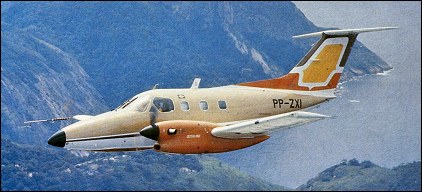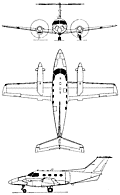 |
Embraer EMB-121 Xingu1976 |  |
| GENERAL-PURPOSE TRANSPORT | Virtual Aircraft Museum / Brazil / Embraer |
 |
Bearing a likeness to the Bandeirante, the pressurised EMBRAER EMB-121 Xingu featured a reduced-span version of the EMB-110P wing, a fuselage of circular cross-section similar to that of the Brasilia, and followed the same general configuration with twin turboprop engines and retractable tricycle landing gear, but differed by having a cantilever T-tail. It was, however, the smallest member of the family, providing accommodation for a crew of two and nine passengers. The prototype Xingu flew for the first time on 10 October 1976, followed by the first production aircraft just over six months later. When production ceased at the end of 1987, a total of 111 had been built, including six for use by the special transport group of the Brazilian air force under the designation VU-9. Other users include the French navy and air force with 41 aircraft, and five others serve with the SABENA pilot training school. The original version, designated EMB-121A Xingu I, was powered by two Pratt & Whitney Canada PT6A-28 turboprop engines. From this was developed the EMB-121A1 Xingu II with 559kW PT6A-135 turboprops, these being available also as retrofits for the Xingu I. Thirty-two earlier machines were later reworked to this standard. A prototype of the EMB-121V Xingu III was flown. It was generally similar to its predecessors except that it had the fuselage lengthened by 0.89m, and was powered by two 634kW PT6A-42 engines. Seating the same number of passengers but in greater comfort, the Xingu III featured an optional 'club' layout for seven passengers, with folding tables and a galley.
|  COMPANY PROFILE | |||||||||||||||||||||||||||||||||||||||||||||||||||||||||
 |

|

